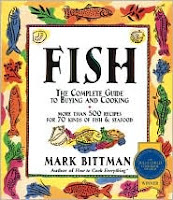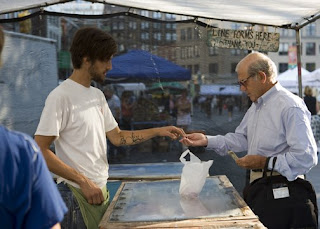 Last week at The Strand bookstore, the universe came to my aid.
Last week at The Strand bookstore, the universe came to my aid.On top of a pile of perfectly stacked new titles stood a misplaced, used copy Fish: The Complete Guide to Buying and Cooking by Mark Bittman. This book by the NY Times bestselling author, was largely foreign to me, as it was published over 10 years ago.
Still the book is very relevant and is a great resource for anyone who would like to cook more seafood. And for me personally, I can’t think of a more appropriate book to supplement my kitchen know-how. Other than the wild salmon, tilalpia, and trout fillets I use from my food co-op, I am largely illiterate when it comes to what’s available in the aquatic kingdom.
This book I believe will change that. Similar to cookbooks I enjoy, Fish is arranged by ingredient – each chapter outlining everything you need to know about a fish – from Perch to Mackarel to Sable.
 Bittman's tips on how to shop for fish, inspired me to pay a visit to my Greenmarket fishmonger in Brooklyn's Grand Army Plaza. I was in search of mackarel, a fish like salmon that is high in Omega 3s. Per his advice, I made sure the fish kept its vivid, rainbow-like color to ensure its freshness. [It did]
Bittman's tips on how to shop for fish, inspired me to pay a visit to my Greenmarket fishmonger in Brooklyn's Grand Army Plaza. I was in search of mackarel, a fish like salmon that is high in Omega 3s. Per his advice, I made sure the fish kept its vivid, rainbow-like color to ensure its freshness. [It did]I asked for a pound of mackarel fillets, using half for dinner that night and the rest the next day. [Unfortunately, mackarel does not keep or freeze well. So make sure to use it up when you purchase it.]
 I tried two of Bittman’s recipes – the Broiled Mackarel Fillets with Mustard Butter was my favorite. It was delicious served over Lundberg’s wild rice blend and some green beans.
I tried two of Bittman’s recipes – the Broiled Mackarel Fillets with Mustard Butter was my favorite. It was delicious served over Lundberg’s wild rice blend and some green beans.The whole experience was so enjoyable, that I plan to make a weekly ritual out of visiting my fish stand every Saturday and trying somethign new.
I love the idea of supporting my local fishermen, who sustainably fish our waters and do not freeze or ship their catch long distances. I also love the taste!
Broiled Mackarel Fillets with Mustard Butter
Taken from Fish by Mark Bittman
Serves 2
2 tablespoons butter
1 tablespoon dijon mustard
1 teaspoon fresh lemon juice
dash cayenne pepper
salt and pepper to taste
1/2 cup freshly chopped parsley
Two 3/4 to 1-pound mackarel, filleted, skin on
Grease the bottom of a baking pan; preheat the broiler. Cream the butter with the mustard, lemon juice, cayenne, salt, pepper, and half the parsley. Spread the fillets with about half this mixture and broil, about 4 inches from the source of heat, for about 5 minutes. Brush the cooked fillets with the remaining mustard butter and sprinkle with the remaining parsley.





